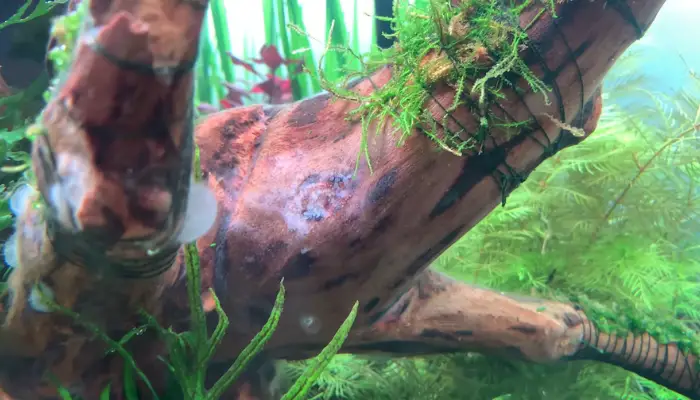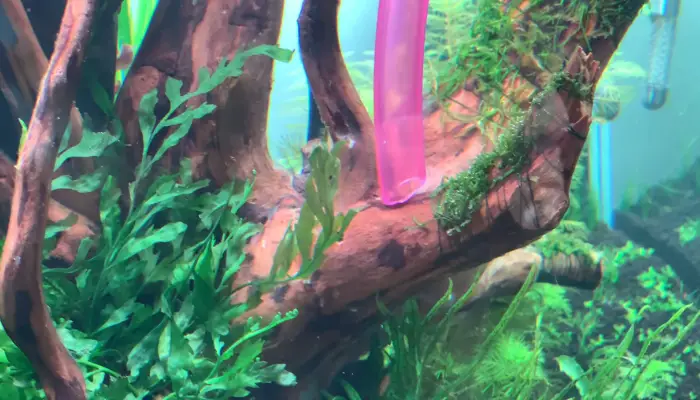White Fungus On Driftwood in Aquarium- Causes & Treatment
White fungus or aquarium fuzz is a common issue in both saltwater and freshwater tanks.
Though these fungi are not harmful to your fish directly, they can disrupt the ecological balance in your aquarium by dropping the water quality.
They find the decors, mostly the driftwoods quite cozy to grow. So, you might have noticed them too. Last time I got too many requests to talk about them, so here I’m today. In this article, I will discuss the growth causes, treatment, and prevention of white fungus on driftwood. So, let’s jump into it.
Before talking about the fixes let’s put some light on this creature.
What Are These ‘White Fungus’?

Driftwood white fungi are some cottony structure or mold, generally a colony of Saprolegnia sp or Achlya sp, or Leptolegnia sp. These are commonly known as ‘white fuzz’ to the aquarists. Most of them have reported some white to greyish film or fur like structure. Such growth can be seen on various surfaces like on the decors, tank walls even on the body of your marine creatures.
Beginners may be baffled with such fungi assuming them as biofilm on driftwood. But if you take a close look, fuzzy growth will be visible. Such fungus is an important sign of poor water quality in your aquarium. So, don’t neglect their presence.
What Causes White Fungus in the Tank?
There are several criteria that can make your tank prone to any fungal attack. It has been observed that small sized aquariums that are less than a capacity of 10 gallons are more likely to develop fungal growth compared to large ones.
If your aquarium is still ‘cycling’, in simple words if the nitrogen cycle in your tank is not completed or all the creatures are not adjusted yet to the new environment, there is a chance of fungal infestation. Whenever I start a new aquarium, I have to face the same problem. So, while establishing a new tank, you need to be more cautious.
Overpopulation is also an important consideration here. More creatures will generate more waste and this will deletoroid the water quality. Slimy and brownish to green water is a clear sign of a poor medium of growth which can lead to the growth of pathogens. Not only the white fungus, brown fuzz on driftwood, and other parts can also be seen in such a case.
Sometimes temperatures below 15℃ and above 30℃ for prolonged periods can give rise to such fungal infestation.
White Fungus on Driftwood in Aquarium Treatment

The treatment depends on the severity of the infestation. I’ve noticed that at the preliminary stage, some minor changes in the aquarium work finely. But in case of a severe outbreak, you may need to be a bit more cautious.
So, it’s important to check the disease severity so that as soon as you notice white mold on driftwood, necessary actions can be taken. Here I have discussed how you can deal with both of the situations. Have a look.
Treatment at The Primary Infestation Stage
This is the stage of minor injury when you may need to manipulate some water parameters in your aquarium.
Proper Cleaning
You can easily remove the fuzzy growth with the help of a cleaning brush or tools from any surface at the initial stage. But as it’s the case of fungal involvement, you have to ensure deep cleaning of your aquarium to eradicate the chance of spreading spores in other parts apart from your driftwood.
There are different aquarium disinfectants available in the market. You can try any of these depending on the creatures you have.
Modification of some Water Parameters
By changing some water parameters you can achieve a better resistance for mold growth. This includes temperature, pH, and humidity management. Also, there should be a balance among the nutrients. These parameters depend on your tank size and living creatures.
After cleaning of affected stuff, set these parameters at an ideal level and try to maintain this at least for a week.
What to Do During a Severe Infestation
When there are multiple incidences of fungal infestation in the tank, it’s considered to be severe contamination. If you are panicking about how to treat such white fungus on driftwood in the aquarium, here I am for the rescue. I got some hacks that may help to deal with the severe fungal infestation. So, let’s roll into this.
Disinfecting the Driftwood
First of all, you need to take out the affected driftwood and clean it properly. Stiff bristle brushes can do this job effectively. After that, give it a good bath to remove as much as fungal spores.
Putting the driftwood in hot water from 55℃ to 60℃ can kill most of the fungal spores. Besides this, an equal portion of water and vinegar mixture also works great. So, you can also give it a shot.
Then you need to dry it completely. Placing them in a warm place for a few hours can help to do this faster.
Finally, use some fungicides to eliminate the chance of further infestation. In this case, pick one which is safe for your aquarium.
This method can be followed for other aquarium decors too.
Changing Water
After disinfecting all the affected parts, you may need to perform several water changes. This will smoothen the establishment of creatures in a better medium.
You can also connect the new tank with your previous aquarium and that must be free of any previous infestation.
During this time, maintain consistent water parameters and look for any kind of fungal growth for at least 2 days. If there’s no sign of new infestation, you can lose the rope.
After that, you are allowed to reintroduce both living and non-living aquarium habitats.
Reintroducing in a Different Environment
If the tank water becomes discolored, you have to remove all the aquarium stuff promptly. After performing the necessary disinfecting steps, introduce them to a sterile medium for growth.
Are you specifically looking for how to treat white fuzz in a fish tank? Let me tell you one thing, in severe cases fish and corals may need rehoming badly. So, provide them an isolated media for some days and practice quarantine methods to observe them.
You must throw away the water and clean the water filter thoroughly. Last time I had to send the filters for professional servicing as the infestation was extreme. So, if you are planning to use the same filter in the new aquarium, try it.
How to Avoid Fungal Growth on Driftwoods
Regular maintenance can keep your aquarium safe from any kind of fungal and bacterial growth. That’s why I suggest adopting preventive measures. Let’s check some of these.
Monitoring Humidity and Temperature
Too much humid and temperate conditions can cause moldy growth in your aquarium. So these need to be maintained properly.
Both the freshwater and saltwater aquariums can increase surroundings humidity up to 30% to 50% by themselves. So, keep checking the levels.
On the other hand, the suggested temperature for aquariums is 25℃. You can keep an eye on the aquarium temperature with sensors or wireless thermometers.
Maintaining Hygiene
Regular cleaning can prevent driftwood fungus in fish tanks. Aquatic plants, corals, and fishes generate a lot of waste over time. These can encourage fungal growth. That’s why you need to check the aquarium filters more often to remove such bio debris. You can also invest in a gravel vacuum or siphon while changing the water.
Changing the water often may help to get rid of aquarium waste. This includes the removal of excessive nutrients and unwanted chemicals. Such water removal can be done at least once every 7 days. In this process, you can discard 10% to 15% of the water each time and refill with new one.
However, not only the aquarium environment but also the equipment used for cleaning should be disinfected thoroughly. I would suggest using a 70% alcohol solution to remove any fungal and bacterial residue from your tools.
Monitoring Nutrient levels
Excess ammonia and nitrates are harmful to fish. This drops their immunity and makes them susceptible to fungal and algal attacks. Also, chemical toxicity can disrupt the ecological balance in your aquarium causing different pathogen attacks.
Such nutrient levels can vary according to the creatures you have. To keep an eye on the nutrient level you can try aquarium strips that will tell you the level of nitrates, ammonia, phosphate, and other compounds.
Monitor these changes and take necessary steps according to your needs.
Avoiding Overpopulation
The presence of too many creatures in one place can cause self-injury of different species in the aquarium. Such wounds trigger fungal growth.
So, to avoid this, be minimal with your picks and choose easy-to-go fishes and corals. Also do not overfeed them to reduce waste accumulation.
Trust me, I have noticed a significant reduction in the fungal association while practicing all these. So, never neglect regular maintenance.
FAQs
How Long Does It Take For Fish Fungus To Go Away?
Normally fishes recover from fungus within 4 to 5 days after establishing in a sterile media. However, you must avoid overpopulating the aquarium to help during the recovery period.
How To Get Rid Of White Algae On Driftwood?
It’s comparatively easy. Scraping the surface of driftwood can remove the algal growth. To avoid such conditions in the future, allow the right amount of light to enter your aquarium.
I Heard Someone Putting Salt In An Aquarium. Is It Safe?
Yes, salts are great to provide electrolytic balance for the improvement of their gill function. This also acts as an antifungal and antibacterial substance in the aquarium. But be careful to pick one specifically formulated for fish tanks.
Conclusion
Keeping driftwood in aquariums can help in boosting fish immunity. These are also important to create a balanced environment for marine creatures.
Here, I tried my best to discuss the facts that can help to deal with the white fungus on driftwood. Don’t just trust my words only, give it a try. I can assure you, you’ll be amazed by the outcome.
Come back to me with any queries about your aquariums. Also, let me know what you would like to know in detail next time.
- 7 Reasons For Anubias Leaves Turning Yellow [Solution] - February 3, 2024
- Types & Sizes Of Aquarium Explained: Guide To Pick The Best One - January 27, 2024
- 15 Best Carpeting Plants For Aquascaping -Beginner’s Pick - January 11, 2024

